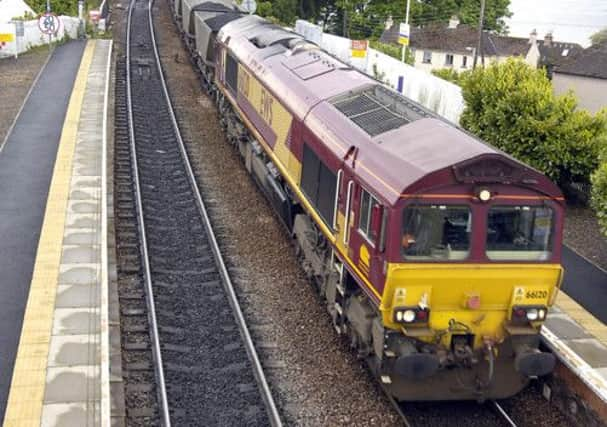Rail Freight Group: how freight can take the strain off the roads


It’s a good question, and the answer is that freight is shifting from road to rail – but a lot more still needs to be done to help the railway reduce the pounding that Scotland’s roads get from 44-tonne lorries.
Rail’s key technical characteristics – steel wheel on steel rail, and a guided track – mean that it can move large flows of freight swiftly and safely. Except where large manufacturers or processors have their own sidings, rail generally does need long distances to compete with road haulage – but there are some important exceptions. Regular trains link the Grangemouth and Elderslie railheads of the Malcolm Group – a major road haulier who uses rail for many of its trunk hauls – and that’s a distance of just 43 miles.
Advertisement
Hide AdAdvertisement
Hide AdMuch of the contribution that rail freight makes to relieving road congestion is unseen, as trains often run at night. Coal to power stations has traditionally been the biggest customer – and Longannet power station is critically dependent on coal brought in by train over the re-opened Stirling-Alloa-Kincardine line. Rail has long been the market leader for overland movement of international containers – one of the positive outcomes of the otherwise “infamous” Beeching Report of 1963 – from Coatbridge Freightliner Terminal to the big five “Deep Sea” ports in England.
But more recently a major new development has been the shifting of supermarket supplies from road to rail. When Safeway made history in 1999 by opting for the train instead of trucks for produce to their Inverness area supermarkets, many an A9 motorist was relieved to find there were fewer lorries on the road north. Nowadays Tesco shift produce from Mossend to the Highlands, and Asda from Grangemouth to Aberdeen, while all the major retailers use rail between their national distribution centres in the English Midlands and regional hubs in Central Scotland.
Much of the supermarket traffic reaches Scotland via the electrified West Coast Main Line, Britain’s busiest trunk freight route – with more than 70 freight trains a day crossing Beattock Summit. But it isn’t just main lines which carry freight and take the pressure off our roads – the “deep rural” Far North Line from Inverness to Caithness, for example, carries regular trainloads of oil from Grangemouth and pipes from Tees-side, plus decommissioned nuclear material south from Dounreay. In total, rail shifts a mighty 14 million tonnes a year across Scotland.
So who benefits from all this rail activity? Manufacturers and processors enjoy a cost-effective and reliable supply chain, and regional economies have the assurance of a resilient alternative to road haulage. Fuel can represent 40 per cent of road haulage costs but typically only around 25 per cent for rail – and electrified railways allow freight trains to be powered by renewable energy sources.
With growing concerns about carbon emissions, rail freight stands out as far superior to road haulage, consuming just one third of road-equivalent energy. Freight on rail is also much safer, and shifting from truck to train offers an effective way to reduce the wear and tear on our roads. A heavy lorry imposes literally thousands of times the damage to road surfaces caused by a car, and Scotland has an enormous backlog of road maintenance – with funds being prioritised for building new roads. But more investment in rail could make a big difference to the daily driving experience of motorists throughout the country.
While the private sector has invested substantially in rail equipment and terminals, the crucial provision of route infrastructure still depends on government. The Scottish Government funds route enhancements by Network Rail and – unlike the situation in England – has also retained the valuable Freight Facilities Grant scheme, which can fund up to 75 per cent of the cost of new rail terminals.
So why isn’t much more freight moving from road to rail? A major factor is the lack of a “level playing field” for competition – and the Perth-Inverness corridor provides a classic example of the disproportionate treatment of the two modes. The Scottish Government proposes to fully dual the A9 at a breathtaking price tag of £3 billion. But proposed rail upgrades remain uncertain, with the maximum investment capped at just £600 million. Two thirds of the rail route is still single-track, adding extra cost and time to rail operations, and the rail enhancements on offer fall very far short of fully dualling and/or electrifying the railway.
The proposed investment in the A9 would transform the economics of road haulage – but what would it mean for freight on rail? The Scottish Government remains silent on this symbolic failure to treat rail and road even-handedly.
• David Spaven is Scottish Representative of the UK’s Rail Freight Group www.rfg.org.uk
SEE ALSO: